Featured snippets are among the strongest strategies for drawing attention to your content. To swiftly and directly address user questions, Google shows highlighted snippets. They appear on a SERP before the top organic results for a given keyword. These snippets can help you increase traffic and reach if you can earn them. Want to know how? Let’s find out!
Table of Contents
- What is a featured snippet?
- Types of featured snippets
- Why does snippets matter?
- Average CTR of a snippet Feature
- So how can you get your content featured on Google?
- 3 Effective Tools for Optimizing your featured snippet
- FAQs for Featured Snippets
What is a featured snippet?
In order to swiftly respond to a searcher’s question, featured snippets are brief text excerpts that are displayed at the top of Google’s search results. A featured snippet’s content is automatically retrieved from websites that are included in Google’s index. Definitions, tables, steps, and lists are typical examples of Featured Snippets.
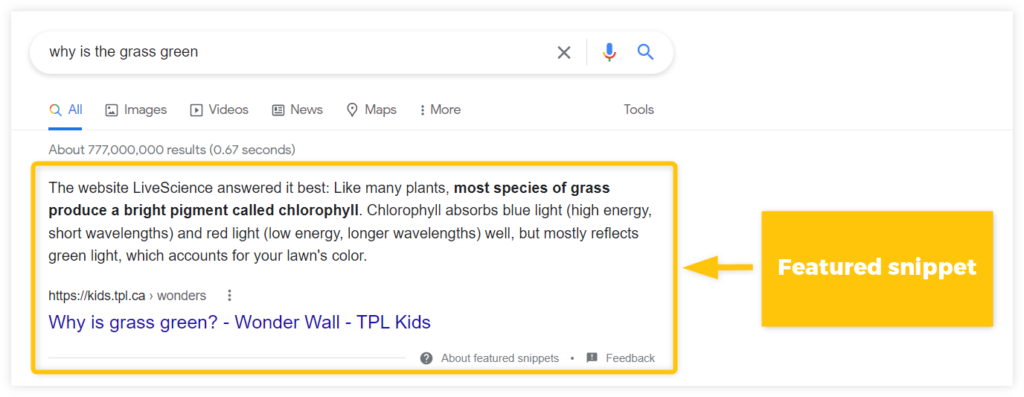
Types of Featured Snippets
There is no one size fits all for featured snippets. Depending on the kind of information a user is looking for, there are a few types that Google and other major search engines utilise.
Before we go into the intricacies of how you can acquire featured snippets by stealing them from your rivals, you must first understand the various types.
1. Paragraphs
A featured text or paragraph fragment is exactly that. A passage of writing that should address your query. The material is typically only an excerpt from a webpage with a link to the relevant page.
Paragraph snippets usually appears when a person searches for questions starting with “How to”, “Why”, Who”, “What”, etc.
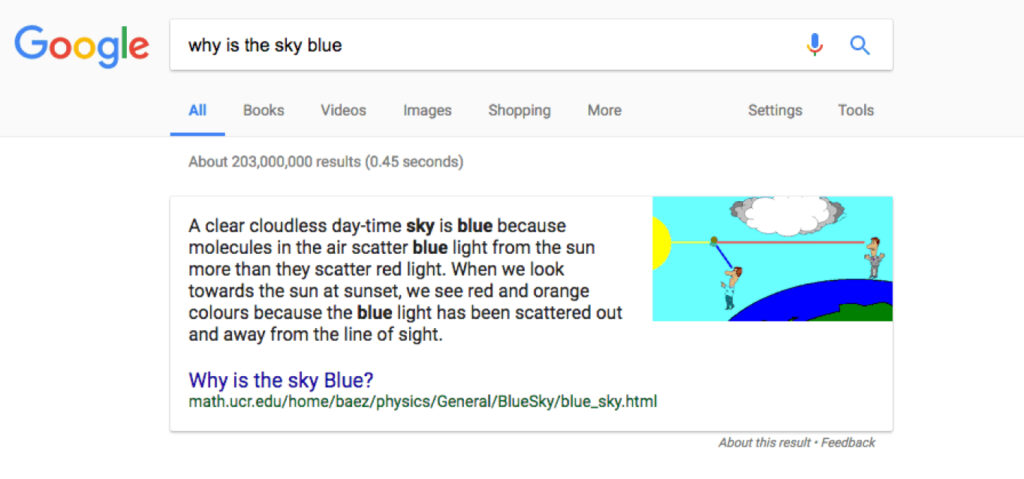
2. Table
You can already figure out from the name itself, here the information is presented in a tabular format when someones searches for a query.
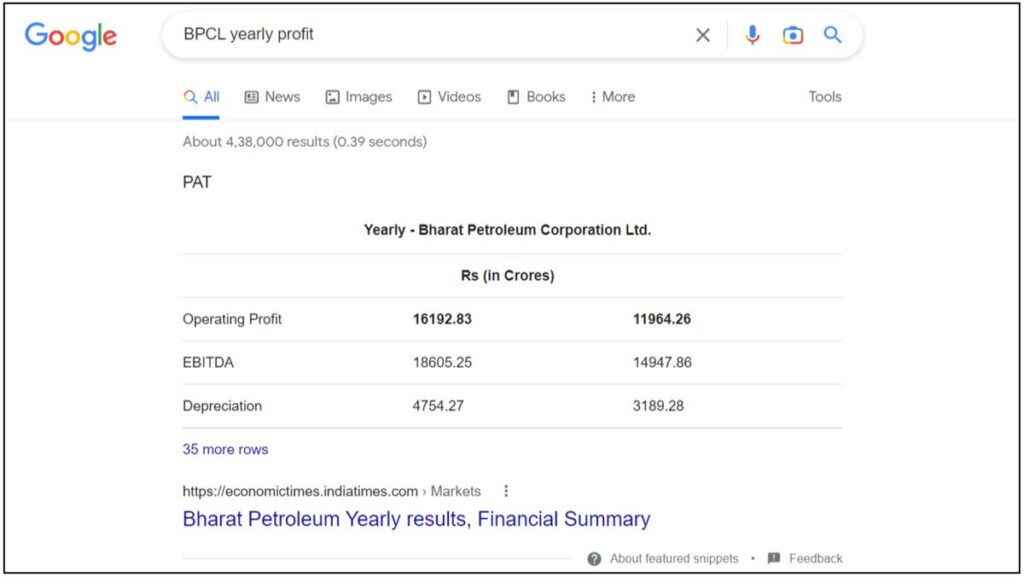
However once again, the information may not be given in a table format on the actual page, but Google will gather the necessary data and build the table for you.
3. List
A result that shows a list as a featured snippet. A top-10 list, a list of steps in a process, a list of ingredients in a recipe, or the actual recipe itself are just a few examples. These can be lists generated by Google by extracting the pertinent data from the page, or they can be lists taken directly from the content.
List featured snippets can be of two types – number lists and bulleted lists.
● Bulleted List
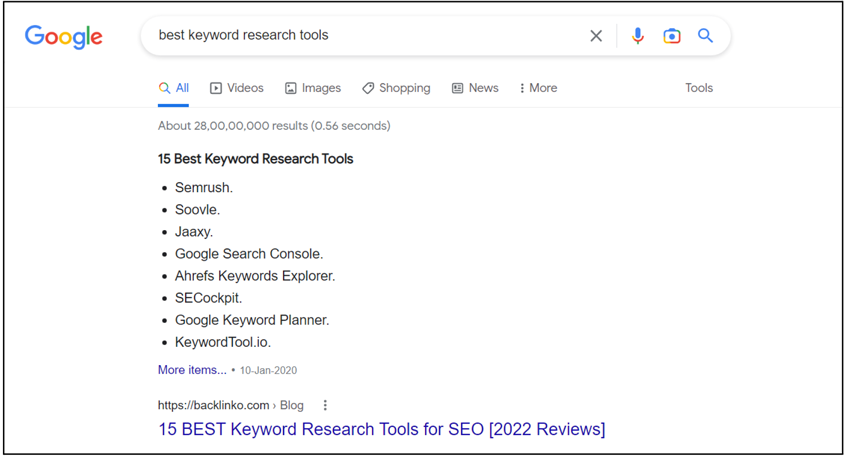
A broad list, where the order of the entries is not crucial, is one that is bulleted. For instance, a list of foods high in iron, a list of books by a particular author, and similar searches.
● Numbered list
A list where the order of the list items are significant is known as a numbered list. For instance, A top 10 List of something or a recipe.
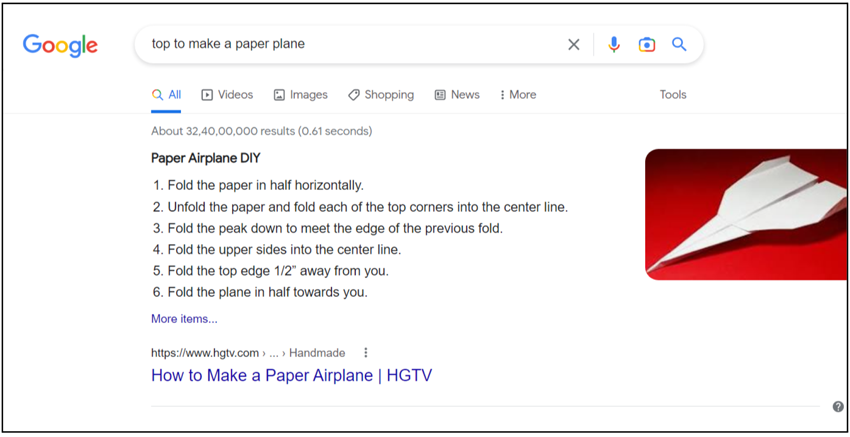
4. Video Snippets
The information that appears on Google with a brief video along with the search result is known as a video-rich snippet. It provides a related video that helps a viewer better understand a specific search query. Additionally, it’s a great technique to raise your search results’ click-through rate (CTR).
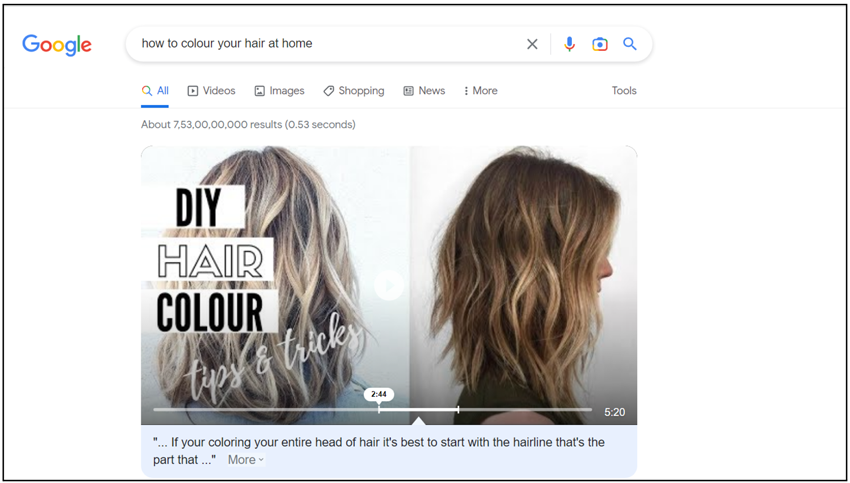
Given that YouTube is one of the most popular search engines on the planet, it makes sense that you’d want to attempt and rank for video-featured snippets as well.
5. Rich Answer
Rich snippets also referred to as “featured snippets,” were the original type of rich answer and are currently used the most frequently. They consist of a text box with a passage of text from a web page, usually accompanied by an image, above the page’s title. These frequently appear for queries with precise, metric-based answers
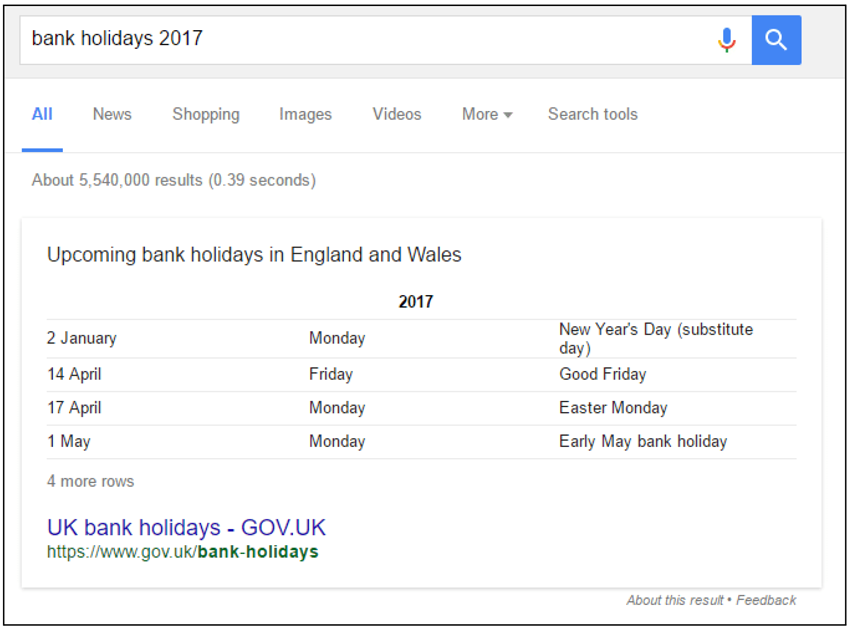
6. Accordion
The searcher’s query is answered with supplementary data, which the searcher can explore to learn more about.

7. Tool or Calculator
A response to the searcher’s inquiry in the form of a user-specific interactive tool. For particularly specific and high-level questions, tools may appear. Calculators, conversions, time zones, weather, game scores, and other tools are just a few examples of the tools that Google displays.

8. Knowledge Panel
When you search for entities (people, places, organisations, and objects) that are part of the Knowledge Graph, Google will display information boxes called knowledge panels. Based on Google’s knowledge of the content that is currently available online, they are designed to assist you in getting a rapid overview of information on a subject.

9. Double Featured Snippets
Google occasionally combines two highlighted snippets or pulls a paragraph’s worth of text from one page and a picture from another to get more comprehensive results.

Why does featured snippets matter?
Many SEO experts quickly came to the conclusion that featured snippets would have a significant negative influence on how many users actually clicked through to the pages inside the results. In reality, this hasn’t been the case. In reality, it has markedly improved the CTR of results that are ranked within it.
- First and foremost, featured snippets are a great way to increase organic search result clicks without improving Google rankings.
- As a matter of fact, because it displays above the standard #1 slot, many SEO specialists refer to the Featured Snippet box as “Position #0.”
Being in a Google snippet can boost your website’s organic traffic and click-through rate.
- According to Ben Goodsell, they witnessed an increase in CTR from 2% to 8% and a 677% increase in revenue from web visitors.
- There are three different kinds that you can use.
- There are 82% sentence fragments.
- 11% are list snippets with bullets or numbers.
- Table snippets make up 7%.
Average CTR of a Featured Snippet
Approximately 8% of all clicks go to featured snippets, according to Search Engine Land. Therefore, if you can get your material into the featured snippet, you can significantly increase your organic click-through rate.

Additionally, there are more “no-click searches” as a result of featured snippets. So, when a Google user doesn’t click on any of the search results. This is so because the Featured Snippet frequently provides the solution someone is looking for.
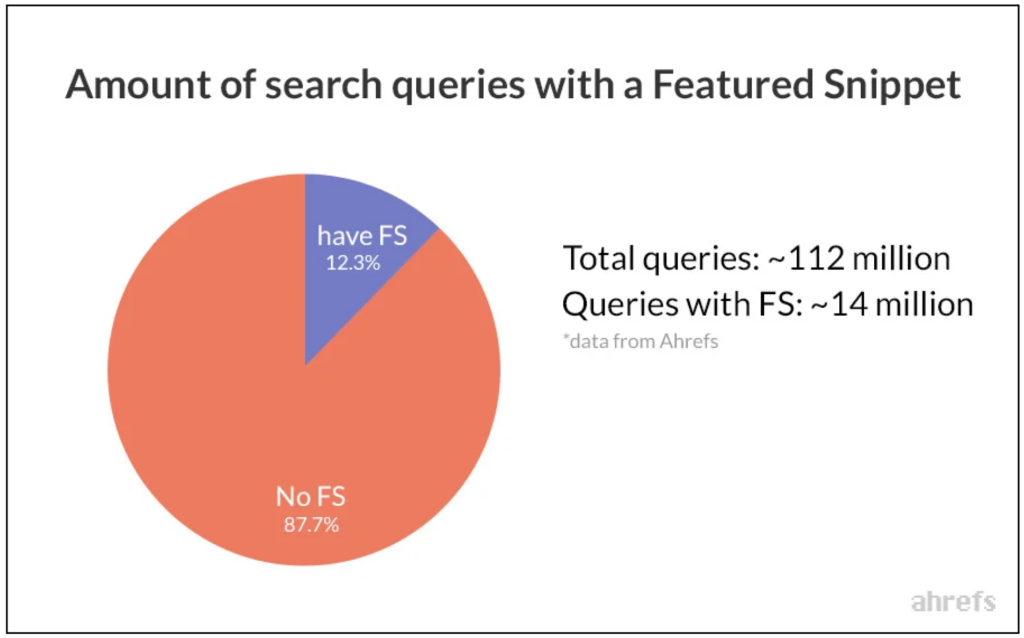
The featured snippet steals clicks from the #1 ranking result.
More specifically, you should take into account Featured Snippets as part of your keyword selection process in addition to competition and monthly search volume.
Therefore, it’s crucial to consider whether or not a featured snippet appears in the search results before choosing a specific keyword. If this is the case, a study of the market conducted by Ahrefs indicates that you would receive fewer clicks than SERPs without a featured snippet.
So how can you get your content featured on SERPs?
Additionally, according to data, almost 99% of featured snippets originate from websites that typically rank on the first page of search results. That implies that it is somewhat based on your ranking. You can compete if your website appears high in search results. The content that ranks on page one is where Google often gets its featured snippets from, although it can also get them from lower-ranking SERPs.
You should optimise for featured snippets if you want to get featured on Google. Naturally, targeting keywords and competitive analysis are included in the phrase “optimization.”
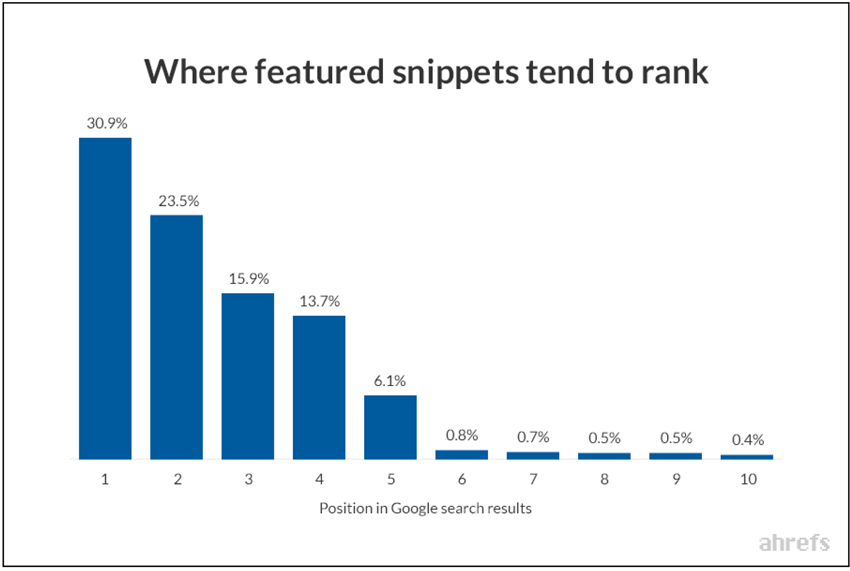
1. Optimizing your content
To start, finding a search results page with a featured snippet is your first step.
- So, you may be sure that Google wants to display a featured snippet for that query. They actually already do!
- You can also view the featured snippet type that Google wishes to display for that term (The Definition, Unordered List, etc.). This makes it very easy to optimise your page for that particular kind of featured snippet.
For instance, you can see that Google offers an ordered List Featured Snippet at the top when you search for “best glass coffee mugs.”
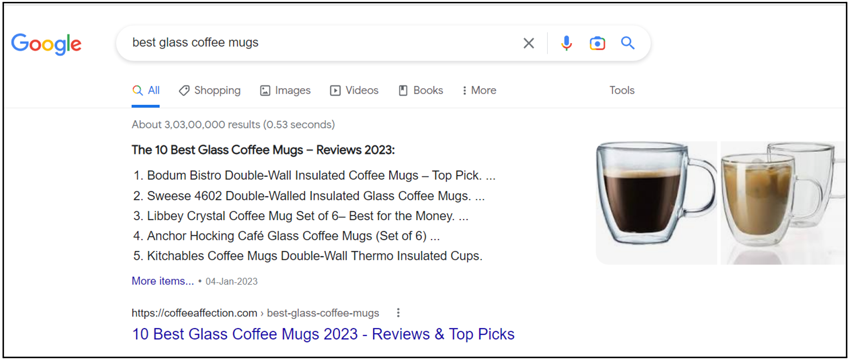
There are two methods for finding SERPs with featured snippets.
To start, you can look for a number of terms one at a time. As a result, if you have a list of possible keywords to target, you may search for each one and note whether or not the results for that term include a Featured Snippet.
- You must give Google a brief text excerpt (40–60 words) that they can utilise in the featured snippet. Having “What is X” just above your definition also helps.
- And because we’re giving Google a word-for-word definition they can use, we got in the Featured Snippet spot within a few months.
- Keep in mind that Google doesn’t want arbitrary definitions to appear. Therefore, try your best to write the definition without expressing any emotion, even if you have strong feelings about the subject. In reality, you ought to format the term like an entry in a dictionary.
2. Usage of a definition-style technique for keywords that aren’t question-based.
It’s considerably more likely that Google will pull through a paragraph of text for shorter, less question-oriented keywords that display a featured snippet (for example, “Inbound Sales”). The majority of the time, Google favours “solutions” that make sense and flow naturally.

3. When appropriate, provide actions for resolving a dilemma or responding to the query
Some responses demand a more thorough justification, frequently comprising a step-by-step procedure. Here, the page structure is crucial. Each step needs to be properly organised as a list or displayed as a header (h3) tag on the page.

4. Look after the length of the content
The highest performance comes from Content that is between 54 and 58 words long for the paragraph-style answers (not the steps).

5. Make use of Effective Headings and Sub Headings
Organizing and arranging your content well is one approach to increase the likelihood that you’ll receive featured snippets. Your material should be organised so that it can give clear responses, and all of your headings and subheaders should make sense in respect to one another.
Take the case where you’re producing articles on how to strengthen your core. Build Better Abs in 30 Days might be your main heading, and the following subheadings might introduce the various exercises you’ll describe:
- Crunches
- Leg raises
- Planks with side raises
Making your information simple to read is crucial as well. To make your material more appealing to readers, vary the length of your sentences and paragraphs.
To make it more logical and clear, use bullet points and lists.
6. For Featured Snippets, less is more in terms of backlinks.
HubSpot’s recommendation for anyone trying to gain more exposure in the Featured Snippet box is to first conduct a fast audit of the keywords that you are currently ranking for in your SEO campaign and determine how many of them are question-based inquiries. Once you have this list, you can investigate your present rankings and the organisation of your material to create a plan to reoptimize it.
7. Takeover your competitors
- You may start optimising your pages for the same terms once you’ve determined which snippets your competitors are ranking for.
- In those featured snippets, you can uncover keywords that your rivals are ranking for and change your content accordingly.
- Another great tool for uncovering the snippets that your rivals have acquired is Google (and that you could earn in the future).
- You might want to check to see if Google now displays featured snippets for keywords that you already rank highly for while looking for all of these things.
8. Putting the Jeopardy Principle into usage
It’s possible that you won’t rank for all of the keywords on the list. You might occasionally add a few words to them.
Applying the Jeopardy Principle is among the finest ways to achieve this. Your keywords should be phrased as a question.
Why? Because a lot of people utilise the Google search bar to enter inquiries.
Imagine that you manage a company that provides training for the Adobe product line.
With articles that serve as brief instructions on how to complete specific tasks in Adobe software, you’re attempting to draw in readers and earn money.
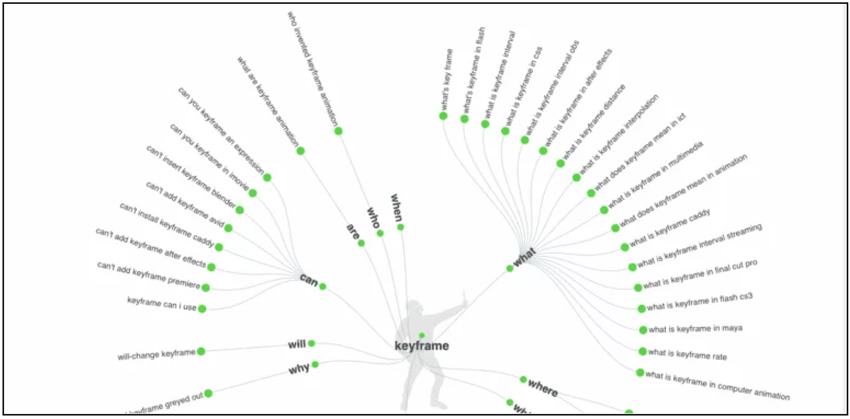
You find out that “keyframe” is a search word that gives you the chance to land a snippet after conducting some research on SEMRush. However, you decide to publish an article titled “What is a keyframe?” rather than simply writing one about keyframes.
The Jeopardy Principle is used in the situation. Your keyword is presented as a question!
9. Paying close attention to the choice of words
We are aware that questions perform remarkably well in terms of getting a position. However, it also matters a lot how you word such inquiries!
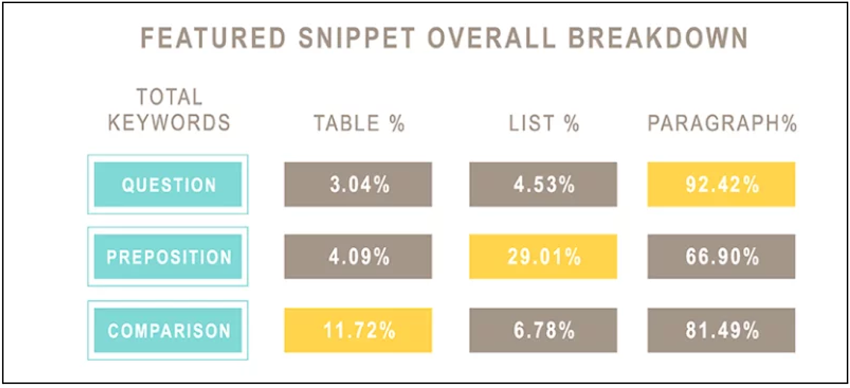
According to a recent investigation examining the subtleties of qualities snippet winners,
- Questions are fantastic
- Nearly all question words—who, what, can, should, and so forth—performed well in summary excerpts.
- How well “have” and “how” performed
- In snippet tables, “Which” performed the best.
- The majority of lists were prepositions (for, like, to, with, and without).
- Comparison words like pricing and vs. received the most tables.
3 Effective tools for optimizing your featured snippets
Given are the helpful tools made to increase your likelihood of being included in a featured snippet.
1. SEMRUSH Position Tracking Tool
A “Featured Snippets Report” is now available in SEMRUSH’s Position Tracking Tool.
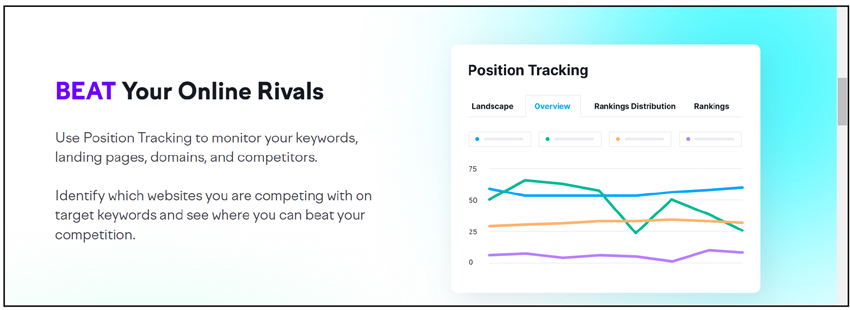
The position tracking tool is useful in that it identifies the keywords you should concentrate on in order to obtain a featured snippet.
You can monitor a website’s daily rankings for a specific set of target keywords with position tracking, also known as rank tracking or SERP tracking. You can adjust your targeting to view content on any particular device type and location (mobile phone, tablet or desktop).
2. Rank Ranger Featured Tool
The Rank Ranger Featured Snippet Tool offers a list of all campaign keywords that have been selected as featured snippets for the top 20 rivals and/or the main domain.

Featured snippet summaries are provided by competitive rank and share graphs, and keywords, domains, landing pages, search volume, and a SERP snapshot are detailed in an analysis table.
Along with a wealth of technical information on what highlighted snippets are and how they operate, Rank Ranger also provides SERP Snapshots.
3. Ninja Tools Featured Snippet Optimization Tool
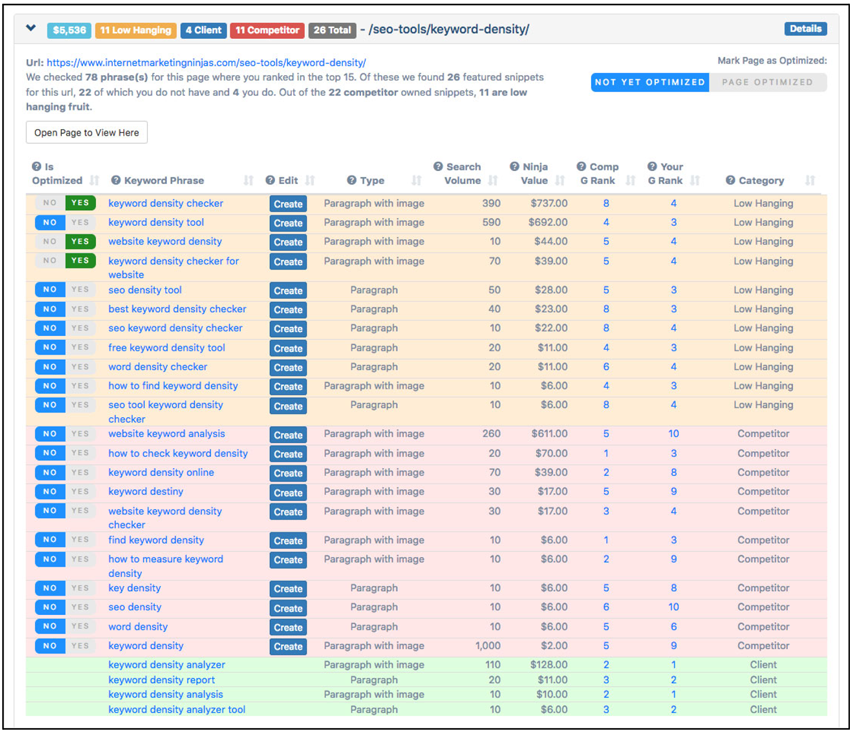
By gathering all the information you want into a usable format, Ninja Tools Highlighted Snippet Optimization Tool aids in getting you featured snippets. It reveals promising keyword phrases from your website as well as information about competitor snippets that you can try to “grab.”
It assists you in developing an optimization strategy by demonstrating the structure that Google could prefer for a specific search term.
FAQS for Featured Snippets
Question 1: Is There Anything That Won’T Appear In A Featured Snippet Box?
Yes. Google’s response boxes won’t display search results for images, videos, local queries, or shopping queries.
Question 2: Do Any Specific Website Codes Help My Content Get A Featured Snippet Spot?
No. There is currently no special markup or code that can be used to optimise the content of your website for a Google snippet. As was already noted, structured markup (Schema) has advantages of its own but does not ensure a snippet spot.
Question 3: Do Snippets Appear On Any Other Search Engines Other Than Google?
No. Additionally, Bing may provide you with results that are different from those of Google.
